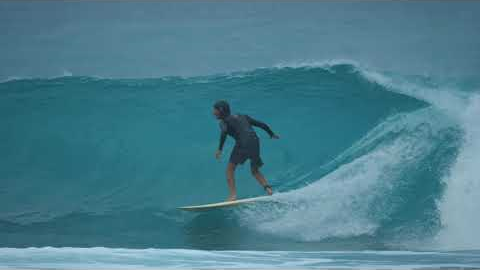Big Island of Hawaii Surfing 1-15-2019 Part 1 Panasonic GH5
5,911 View
Share this Video
- Publish Date:
- July 13, 2025
- Category:
- Surfing
- Video License
- Standard License
- Imported From:
- Youtube
Tags

"To use this video in a commercial player, advertising or in broadcasts, please email Brave Bison at [email protected]
***Read The Description***
The tenth in a series of local surfing videos.
Loaded so everyone I surf with can see videos of themselves surfing.
I get the Good The Bad and The Ugly.
I try and get everyone out there at their best whether they're shredders or cruisers.
Shot with my Panasonic GH5 and the Leica 100 - 400mm. Dual image stabilization. Sennheiser MKE 440 Mic. 4k 60 fps.
Software updates in 2018 fixed any autofocus issues with the GH5. If you ever experience issues afterward I'd check your battery. One of mine was failing and it caused subtle camera issues.
The early videos may have a bit more stutter to them meaning I had the camera on a tripod but, later figured out handheld was the best way to shoot with the camera set up I was using.
I'll be launching a new video daily until I'm all caught up.
I won't be saying what locations these were shot at or who may be in them.
Audio is the ocean while I was shooting. You can always hit mute and listen to your favorite music.
The volcano stopped months ago and it could be years before it gets going again. I have tons of other videos I've been wanting to make so, now I can get busy on them.
None of them are easy adventures so, it's going to be a slow process.
Thanks for your patience and for subscribing.
Website http://lavapix.com/#/page/home/
Social networks
Instagram: https://www.instagram.com/lavapix/
Wordpress: http://lavapix.wordpress.com/
twitter: https://twitter.com/lavapixcom
Facebook: (Haven't posted in years) https://www.facebook.com/lavapixcom-2...
***All content copyright protected 2019 © Bryan Lowry / lavapix.com All rights reserved worldwide***
PayPal Payments https://www.paypal.me/BryanLowryLavapix
-----------------------------------
Beach Safety Guidelines: Lifeguard Tips, Sun Protection, Water Safety, Rip Currents, First Aid & Emergency Procedures
Spending a day at the beach is a favorite pastime for many, offering sun, sand, and surf. However, ensuring safety for yourself and your loved ones is paramount. Whether you're a seasoned beachgoer or planning your first seaside adventure, understanding beach safety guidelines can make all the difference between a fun day and an unexpected mishap.
Lifeguard Tips
Always pay attention to lifeguard warnings and instructions. Lifeguards are trained to spot potential dangers early, such as strong rip currents or sudden changes in weather. They provide invaluable advice on safe swimming areas and can alert you to hazards you might not notice from the shore.
- Observe the Flags: Different colored flags signal specific conditions. Red usually means dangerous water conditions, while green indicates safe swimming areas.
- Heed the Warnings: If a lifeguard signals to stay out of the water, respect their authority and find an alternative activity.
Sun Protection
Protecting yourself from the sun is crucial to avoid sunburns, heatstroke, and long-term skin damage. Applying sunscreen regularly and seeking shade can help you enjoy the beach without the harmful effects of UV rays.
- Use Broad-Spectrum Sunscreen: Choose a sunscreen with at least SPF 30 and reapply every two hours, or more often if you're swimming or sweating.
- Wear Protective Clothing: Hats, sunglasses, and long-sleeved shirts can provide additional protection against the sun.
Water Safety
Understanding water safety is essential for preventing accidents. Whether you're swimming, surfing, or engaging in other water activities, knowing the basics can save lives.
- Swim Within Your Limits: Even if you're a strong swimmer, never underestimate the power of ocean currents and waves.
- Stay Hydrated: Dehydration can impair your judgment and physical abilities, making it harder to stay safe in the water.
Rip Currents
Rip currents are powerful, narrow channels of water that can pull swimmers away from the shore. Recognizing and knowing how to handle rip currents is vital for beach safety.
- Identify Rip Currents: Look for areas where waves are breaking strongly offshore or paths of choppy, disorganized water.
- What to Do If Caught: Stay calm, conserve energy, and swim parallel to the shore until you're out of the current, then return to the beach at an angle.
First Aid
Minor injuries can happen even on the safest beaches. Being prepared with first aid knowledge can help you address issues promptly and effectively.
- Basic Supplies: Keep a first aid kit handy with bandages, antiseptics, and other essentials.
- Learn CPR: Knowing CPR can be lifesaving in emergencies where someone isn't breathing or has no pulse.
Emergency Procedures
Having a plan for emergencies can significantly improve outcomes during unexpected situations. Familiarize yourself with local emergency procedures before heading to the beach.
- Know the Location of Help: Identify the nearest lifeguard station, medical facility, and evacuation routes.
- Stay Informed: Keep a fully charged phone or a whistle to call for help if needed.
Remember the last time you enjoyed a day at the beach without a hitch? Chances are, it was because you followed these safety guidelines. By staying aware, prepared, and respectful of the ocean's power, you can create memorable and safe beach experiences for everyone involved. So next time you pack your beach bag, make sure safety essentials are on the list—it’s a small step that leads to a big peace of mind.
Did you miss our previous article...
https://trendinginhawaii.com/surfing/beginners-guide-to-surfing-in-maui-amp-hawaii-the-adventure-buddies














